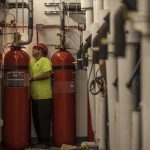
There are many types of fire suppression agents that are used to protect people and properties from fires. It can be hard to know which type of suppression agent is right for you. Clean agent fire suppression systems are a popular choice for applications that need a fast-acting, safe and clean form of fire protection.
What is a Clean Agent?
A clean agent is a fire suppression agent that is gaseous, does not leave any residue behind and is electrically nonconductive. Clean agent fire suppression systems use either an inert gas or a chemical agent to suppress a fire.
Common Types of Clean Agent Suppression Systems
Three common types of clean agent fire suppression systems include:
- FM-200: Highly versatile agent that is a compound of carbon, fluorine and hydrogen and can be used in a wide range of applications
- 3M™ Novec™ 1230: An eco-friendly clean agent that is often used to protect sensitive assets or equipment.
- Inert Gases: A combination of nitrogen, argon and carbon dioxide that is used to flood an area and lower oxygen levels to the point where combustion cannot occur.
Benefits of Clean Agents
- Fast Acting
- Environmentally friendly
- Electrically nonconductive
- Safe to use in occupied areas
- Minimal downtime
- No cleanup
Where Should I Use Clean Agent Systems?
Some common applications where clean agent fire suppression systems are used include:
- Data centers and telecommunication facilities
- Museums
- Record and file storage
- Server rooms
- Laboratories
Reliance Services Clean Agent Suppression Systems
Reliance Fire Protection can provide design, installation, inspections, testing and service for clean agent fire suppression systems. We have experience working with a wide range of applications. We serve clients in the Baltimore, MD and Washington D.C. areas. To learn more about our services, contact us today.
